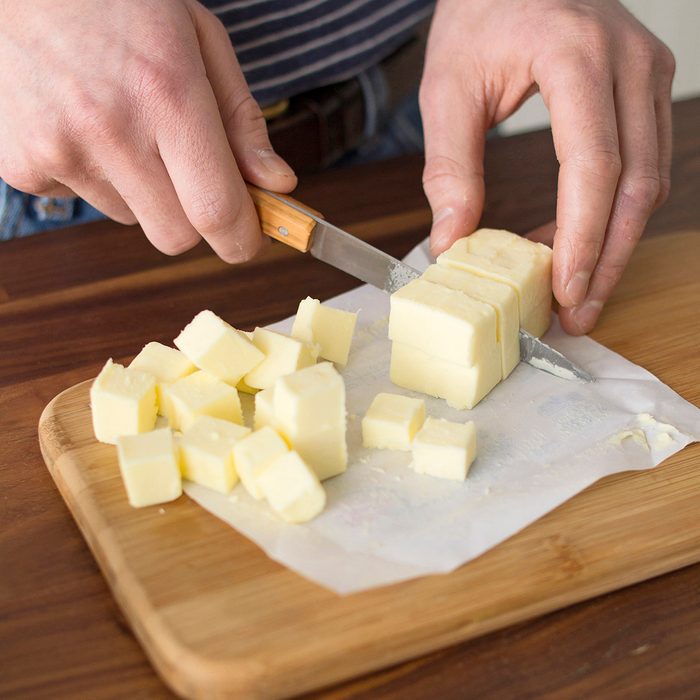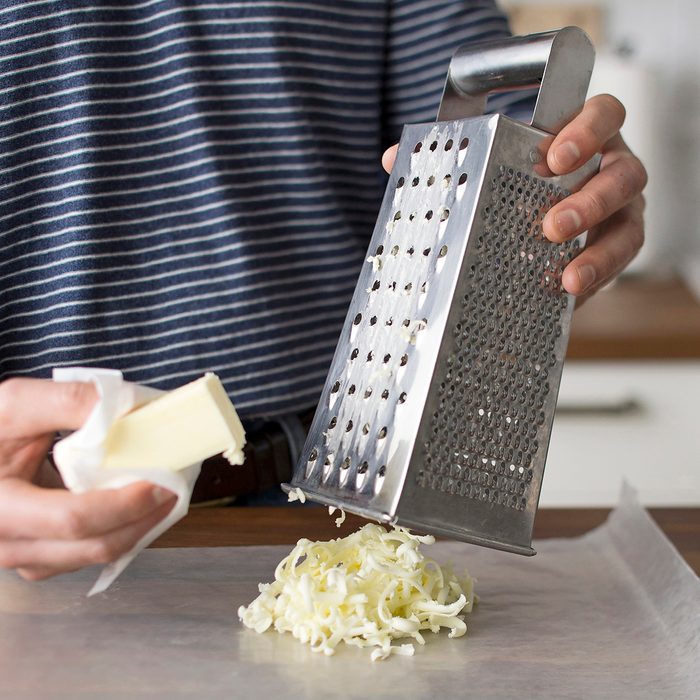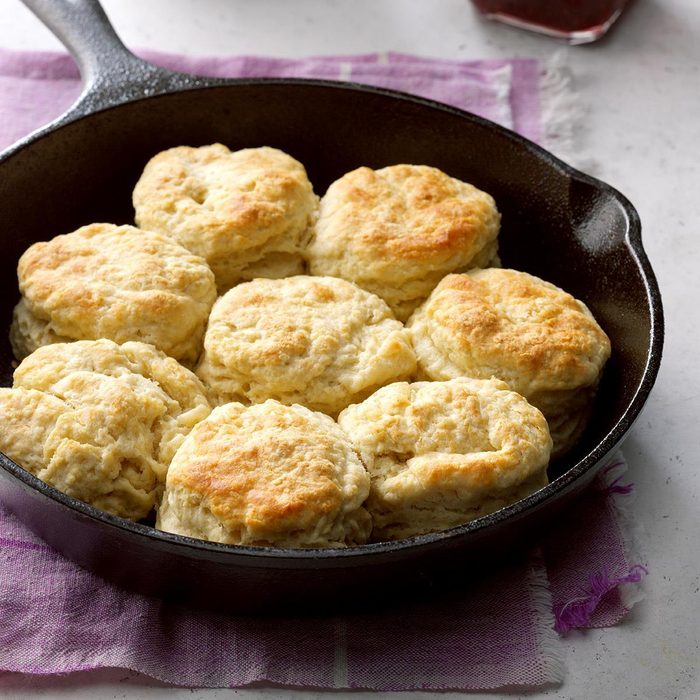
Make no substitutions
In a pinch, milk with a squeeze of lemon juice is a fine buttermilk substitute. However, in a simple recipe like biscuits, Prep Kitchen Manager Catherine Ward advises against it. “This is not the time for substitutions,” she warns.
Instead, be sure to add buttermilk and all the appropriate ingredients to your grocery list. Your biscuits will taste better for it. If you run out of it, then here are a few substitutes for buttermilk that taste the same.

Use good butter and dairy
“Use the best butter you can afford,” Catherine recommends. Because biscuit recipes call for so few ingredients, it’s important that every one is high quality—you’ll really taste the difference.
Catherine recommends splurging a bit on a grass-fed butter or European-style butter (now’s the time to reach for Kerrygold!). Same goes for buttermilk and cream. Snag a pint of the good stuff.

Skip the biscuit cutters
According to Shannon Norris, senior food stylist, it’s best to skip the biscuit cutters when making biscuits. “I use a bench scraper to cut squares instead of a round cutter. Then you don’t have waste or to reroll scraps,” she says.
Ideally, you want to handle the biscuit dough as little as possible, so by skipping that bit of rerolling, you can make sure your dough is as minimally handled as possible (which means the dough stays cold and the biscuits are flaky).

Only reroll the dough once
If you’re set on having round biscuits, that’s OK! Just be sure not to overwork the dough by rerolling it many times. Constantly working with the dough not only melts the butter (and cold butter is the secret to fluffy biscuits) but it develops gluten—and that can cause tough, chewy biscuits.
James Schend, Taste of Home deputy editor, recommends only rerolling the dough one time. This will keep the dough tender and the biscuits nice and flaky. Also, when you use that cutter, press down—no twisting. “If you twist and wiggle, the biscuits will rise in the oven at odd angles,” he says.

Weigh the flour
The secret to better baking is weighing your ingredients—especially flour. “I’ll keep saying this until I’m no longer breathing,” James jokes (kind of).
Weighing provides the most accurate measurements, and since baking is so scientific, precision is key! Invest in a good kitchen scale (this is our Test Kitchen’s favorite scale) and remember this one measurement: one cup of flour is 125 grams. Getting this right will improve all your bakes, including biscuits.

Grate the butter
Josh Rink, senior food stylist, recommends grating ice-cold butter instead of cubing it up. These shreds can be cut into the biscuit dough more quickly than cubed butter.
You can even do this in advance. “Just toss the shreds with a tiny bit of flour to keep them from sticking,” Josh recommends.

Use your food processor
Another way to keep your hands off the butter in your biscuit dough is to not touch it at all! Catherine recommends popping the dry ingredients into a food processor with cold, cubed butter. Pulse a few times, then transfer into a mixing bowl to add the wet ingredients.

Make sure your baking powder is fresh
While baking powder has a relatively long shelf life (about a year), it’s important to make sure this leavening ingredient is still fresh before you add it to your biscuit recipe. Baking powder is what gives biscuits their lift, so you want to make sure it’s fresh and ready to do its job. If you’re not sure if your can of baking powder is still good, you can test it.

Mix the dough gently
When it comes to biscuit dough, handle with care, according to James. You don’t want to overwork it. The more you touch the dough, the more likely the butter is to melt, and the more you mix and knead it, the tougher the biscuits will become. Mix until just combined and shape until the dough just comes together—no need for any more work.

Chill dry ingredients too
You already know that cold butter is the secret to flaky biscuits, but according to senior food stylist Josh Rink, making sure your other ingredients are cold, too, doesn’t hurt.
“I like to throw my dry ingredients in the freezer to get super chilled, so when that cold biscuit dough hits the hot oven, you get nice puffy, flaky layers,” he says.

Bake the biscuits close together
When it comes to biscuits, the taller and flakier the better, right? To help your biscuits get a bit more height, Food Editor Rashanda Cobbins recommends placing biscuits close together on your sheet pan or skillet. Having the biscuits just touching (but not smooshed together) helps them cling to one another to climb just a smidge higher. Try this out with these skillet buttermilk biscuits.

Use flour with low protein content
To make extra tender biscuits, you don’t want to develop a lot of gluten. Flours with a higher protein content develop gluten more readily. To get the soft biscuits you’re after, Catherine recommends using for an all-purpose flour with a small amount of protein.
“Look for something with 3 grams of protein per 30 grams—usually the standard portion size on a bag of flour,” she advises.

Experiment with mix-ins
Yes, a classic buttermilk biscuit is delicious on its own (or topped with honey, jam or butter), but you can add some personality right into the biscuit dough. Peggy Woodward, senior food editor, says, “I can’t resist adding some garlic powder and shredded cheddar to pretty much any biscuit recipe I make.”
You can follow Peggy’s lead or experiment with flavors you love. Herbs, cheeses and spices are all welcome additions to homemade biscuits.

Brush the biscuits with butter after baking
“If you want the most luscious biscuits ever, brush the tops with melted butter after they come out of the oven,” says James.
Brushing the butter on after baking ensures that the butter soaks into the baked biscuit so you get that great buttery flavor in every bite. That’s exactly the technique used in this top-rated Southern buttermilk biscuit recipe.
